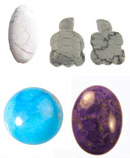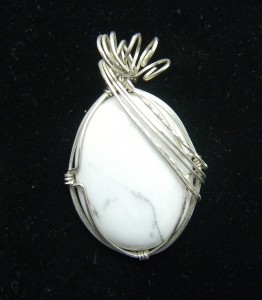- NEW DVD Series – Stone Setting with Bezels
- Tube Set Charm by Kim St. Jean
- Prong Basket Pendant by Kim St. Jean
- NEW DVD Series – Stone Setting with Cold Connections
- New DVD Series – Stone Setting with Wire
- NEW DVD Series: Introduction to Stone Setting by Kim St. Jean
- Featured Tool: Bracelet Bending Plier
- NEW Dvd by Eva Sherman
- Fun, Fast Fold Forming DVD Series
- Double Band Ear Cuff from Alex Simkin
Gem Profile Oct. 12: Howlite
by Rose Marion, Wire-Sculpture.com

Howlite
Shop Howlite Cabochons | Shop Howlite Beads
You learned last week that copper is the big element that sets turquoise apart from magnesite. Today’s stone, howlite, is made of Calcium, Silicon, Boron, Hydrogen, and Oxygen, but no copper here, either. Like magnesite, howlite loves to absorb dye, especially turquoise-colored dye, to give us the look of turquoise without the high price.

Peggy Marzano wrapped this turquoise howlite cabochon in a bracelet with sterling silver and 14kt gold filled wire.
"How"ever, turquoise isn’t the only stone that howlite likes to dress up as. Howlite may be dyed red to resemble red coral, or blue to resemble lapis lazuli. And howlite is still valued in its natural white state, with its gray and black veins, which sometimes may be slightly brown. Magnesite veins are more typically tan or cream, which is a way to differentiate the two similar stones.
Howlite was named for Henry How of Nova Scotia, who was the first geologist to describe the mineral, in 1868. In the mine, you might find howlite crystals, which may be transparent to cloudy brown, as well as opaque. Opaque howlite is typically cut into beads or cabochons, rather than faceted like a translucent gemstone.
Other names for howlite include turquenite (when dyed turquoise), white turquoise, white buffalo stone, and white buffalo turquoise. This is a misleading name, since the stone is unrelated to the legend of the white buffalo or any buffalo at all, and it’s also a misleading marketing attempt to equate the stone with turquoise.
Howlite is found in Newfoundland, New Brunswick, and Nova Scotia, Canada; Nevada and California, US; Mexico; and in some parts of Europe, including Germany, Turkey and Serbia. (I was surprised to finally find a stone that’s not listed in Brazil – but perhaps the list was incomplete!)
When howlite isn’t being formed into beads and cabochons, it is carved into ornaments or the boron in it is extracted for industrial use. Like magnesite, howlite rates about a 3.5 on Moh’s scale, which is fairly soft, and softer than real turquoise, which has a hardness of 5-6. Some samples of crystalline howlite, however, were found to be as hard as 6.5 by minerologists in Nova Scotia (source) – practically as hard as quartz!
Possibly because of its coloring, or because of its calcium makeup, howlite is thought by some to aid in healing of the bones and teeth. Howlite is said to soften a critical, selfish, or rude nature, and provide a calming influence. Some metaphysical believers attribute howlite with memory enhancing strengths.
Next week, on Friday, I think it’s time for another contest! And I’ll attempt to make this more fair for our West Coast friends: the post will be live at approx. 10am Mountain Time (12 noon Eastern). Watch your email for details!
Resources & Recommended Reading
- Howlite on WebMineral
- Howlite on Galleries
- Howlite on TrinityLondon
- Howlite on Wiipedia
- Howlite on MinDAT
Gem Profile by Rose Marion
Click to Receive Daily Tips by Email






















Bea Morris
October 12, 2012 at 10:58 am
Hi. As noted it is easy to dye howlite, but do you know of a way to tone down the dye after it has been applied. Got some pretty howlite beads that have been dyed the most hidious colour and would like to save them if possible. Thought of soaking in a bleach/water rinse but wasn’t sure if it would in fact effect the stone. Hope you can help. Regards Bea
Rose
October 12, 2012 at 1:57 pm
Hm. Good question, Bea! I bought some dyed magnesite cabs in Tucson for practicing with. The vendor told me that it was a sugar dye, and to be careful in the sun – he said I could leave them on the back porch in the sun for a month, and they’d be bleached back to white. So that’s one idea.
I would also just try soaking them in soapy warm water for a bit to see what happens before moving to heftier chemicals. I’ve heard tumblers and ultrasonic cleaners shouldn’t be used on dyed stones, so you could try those methods, too.
As with anything, take just one bead off the strand for your experiments, so the rest are safe. Let us know how they turn out!
chris hurd
October 12, 2012 at 12:29 pm
Howlite is also friend of turquoise fakers. Its a nice stone on its own, but unscrupulous dealers will try to pass it off as the real thing
Rose
October 12, 2012 at 1:54 pm
Yes, Chris. I only know 3 ways to figure out if it’s a fake: break it open (if it’s white inside, it’s fake – although the dealer might not be amused); look at the price tag (if it’s inexpensive, it’s likely not genuine); and being familiar with the colors of the natural stone – for example, some dye jobs can come out “too” good, like a neon turquoise or there’s inconsistency in the dye.
Do you have any tips on spotting the fakes?
Lynda Clardy
October 13, 2012 at 6:14 am
how do you dye stones??? I also have some that are over dyed and the kinda look like Easter eggs,,to much of a good thing,,needs to be toned down,,,Thank You ,,,any information greatly appreciated…
Rose
October 15, 2012 at 8:41 am
Hm, I have no idea, Lynda! I will look for more information on that and perhaps it will turn up in an article here on the blog! Does anyone have any tips on dyeing stones for Lynda?